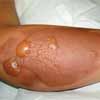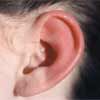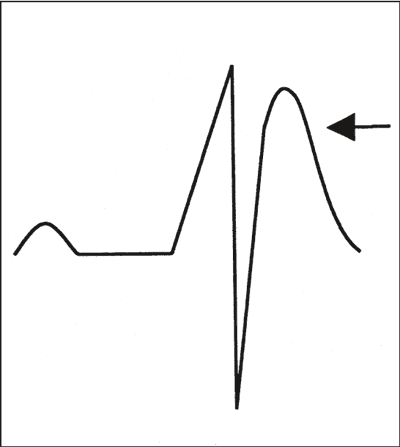Cold Injuries: A Guide to Preventing--and Treating--Hypothermia and Frostbite
ABSTRACT: Hypothermia is not limited to the northern states: people also die of hypothermia in other areas with milder climates. Infants, young adolescent boys, and inadequately dressed teens who abuse alcohol or illicit drugs are at highest risk for death secondary to hypothermia. The mildly hypothermic patient may appear fatigued and display persistent shivering, ataxia, clumsiness, confusion, tachypnea, and tachycardia. The child with moderate hypothermia will not be shivering; declining mental status may cause the freezing patient to remove clothing. An irregular heartbeat is likely at this stage. Severe hypothermia is marked by apnea, stupor, and coma. In a frostbitten patient, rapid rewarming of the affected area in warm water for 15 to 30 minutes is the first step. Potent analgesia is often necessary. After thawing, the frostbitten part is kept dry, warm, and loosely covered. With an adequate dose of common sense, the vast majority of deaths from cold injury can be prevented.
Even in the winter, children should be encouraged to play outdoors. Such exercise has significant cardiovascular and musculoskeletal benefits. However, those benefits must be weighed against the risk of potential localized or systemic consequences of excessive exposure to cold. Hypothermia is life-threatening. Localized injuries are typically less severe but may be accompanied by generalized hypothermia and are associated with great morbidity and even death (Table 1).
By understanding the epidemiology and pathophysiology of hypothermia, cold-related deaths can be prevented.1 Here we describe effective preventive measures. We also review various types of cold injuries and discuss their treatment.
EPIDEMIOLOGY
Hypothermia is defined as a core temperature at or below 35ºC (95ºF).2 It can be categorized as:
Mild: 34ºC to 35ºC (93ºF to 95ºF).
Moderate: 30ºC to 34ºC (86ºF to 93ºF).
Severe: less than 30ºC (86ºF).
Certain factors--such as age or preexisting medical conditions--increase the risk of hypothermia (Table 2). Hypothermia is not limited to the northern states: other areas of the country with milder climates (the Carolinas and Virginia, for example) have also reported deaths from hypothermia.3,4 The majority of these deaths occur in November through February.1 Each year, approximately 500 deaths are attributed to hypothermia; about half the victims are 65 years or older and two thirds are male.4 Fortunately, fewer than 20 children younger than 20 years die every year of overexposure to the cold: the vast majority of these deaths are preventable.4 Children at highest risk for death secondary to hypothermia include infants younger than 1 year, boys in early adolescence, and inadequately dressed older adolescents who abuse alcohol or illicit drugs.2,4
The most clinically significant type of localized cold injury in the pediatric population is frostbite, which implies actual freezing of tissue. Like burns, frostbite is rated by degrees (see Table 1). First degree is the mildest and most superficial type. Fourth-degree frostbite involves the freezing of subcutaneous tissue, muscle, and bone.
The number of cases of localized cold injuries that occur per year nationally is unknown. The American Red Cross predicts that thousands of people can expect to experience frostbite in the winter months.5 The burden of this cold- related problem outside the United States is revealed in a study from Finland: the authors reported that the lifetime and annual incidence of frostbite among military servicemen (some as young as 17) was 44% and 2.2%, respectively.6
PATHOPHYSIOLOGY
Human core temperature is normally maintained within 0.6ºC (1ºF). Hypothermia occurs when the body's ability to conserve adequate heat is overwhelmed. Heat is lost via radiation, conduction, convection, and evaporation. The reaction of the hypothalamus to neural feedback from environmental sensations is the key component of temperature regulation. Changes in cutaneous circulation help maintain core body temperature. Radiation or heat transfer from a relatively warm body into a colder environment is responsible for the majority of heat lost. This phenomenon is particularly important in infants and young children because of their greater body surface area-to-mass ratio. When a child is in cold and wet clothing or submerged in cold water (such as in drowning), heat loss is increased through conduction. Through convection (which accounts for the wind chill index), cold wind also increases heat loss. Evaporation is a source of heat loss, particularly for a newborn immediately after birth in the delivery room.
Normally, peripheral vasoconstriction occurs when the ambient temperature is about 15ºC (59ºF).7 Other generalized bodily responses include sweating cessation, shivering, and release of such chemicals as epinephrine and thyroxine to increase heat production. The body's intense response to persistent cold leads to significant adverse effects on the major organ systems (Table 3).
Peripheral vasoconstriction di- verts blood to the kidneys, which causes an initial diuresis with resultant decreased intravascular volume. Blood flow to the brain is eventually decreased, resulting in CNS depression of various degrees. CNS abnormalities are progressive. Each drop in temperature of 1ºC produces a 6% to 7% decline in cerebral blood flow.8
The heart responds with initial tachycardia; eventually, bradycardia and arrhythmias ensue. Apnea, adult respiratory distress syndrome, and aspiration pneumonia are serious pulmonary consequences. The metabolic acidosis, respiratory acidosis, hypokalemia, and hypoglycemia that accompany severe hypothermia wreak havoc on all bodily functions. Coma, cardiac and renal failure, and respiratory arrest are the end points if the hypothermia is untreated.
Localized cold injuries in children result mainly from inadequate protection against the environment. The most peripheral body parts (fingers, nose, ears, toes), which contain abundant arteriovenous anastomoses that shunt blood to the body's core, are the most vulnerable to injury. Cold objects (eg, a popsicle or ice pack) placed against the skin for prolonged periods can also injure the skin (Figure 1).9 Local damage occurs when tissue temperature drops to 0ºC (32ºF) (Figure 2).7

Figure 1

Figure 2
A freezing cascade that leads to frostbite has been described7:
The first, or prefreeze, phase involves the loss of skin sensation, vascular constriction, and endothelial plasma leakage.
The development of ice crystals in the extracellular fluid causes water to move out of cells: the result is cell shrinkage and collapse during the second, or freeze-thaw, phase.
The third, or vascular stasis and progression of ischemia, phase is characterized by endothelial cell damage, necrosis, and sloughing of dead tissue in the affected area.7
The stasis and thrombosis that occur in the affected body part provide a conducive environment for gangrene. Sequelae of frostbite depend on the depth of damage sustained. First-degree frostbite can lead to telangiectasias,10 for example, while the most severe types lead to permanent disability (arthritis, premature epiphyseal closure), disfigurement (deformed digits), or amputation of the involved body part.11,12
HYPOTHERMIA
The history. A detailed account of the child's symptoms and accompanying environmental conditions usually suggests the diagnosis of hypothermia. Accidental hypothermia may occur indoors in poorly heated homes or outdoors. Those affected may include scantily dressed toddlers who wander outdoors, lost mountain climbers, hikers, backpackers, skiers, and near-drowning victims.13 In the hospital setting, iatrogenic hypothermia may occur during neonatal resuscitations.
The medical history should focus on any underlying medical conditions. When evaluating a cold-injured child, 2 initial steps are crucial:
Measure vital signs, including the core body temperature with a low-reading thermometer.
Provide the ABCs of emergent care.
Examine the child for clinical features of hypothermia or frostbite. In mild hypothermia, the patient may appear fatigued and display persistent shivering, ataxia, clumsiness, and confusion. Tachypnea and tachycardia are usually present.14
The child with moderate hypothermia will not be shivering (the body loses its ability to warm itself). Declining mental status may cause the freezing patient to remove clothing (a phenomenon known as paradoxical undressing). An irregular heartbeat is likely at this stage.14
In severe hypothermia, apnea, stupor, and coma are probable features. Cardiac monitoring may reveal pulseless electrical activity, atrial fibrillation, ventricular ectopy, or even asystole.15
Frostbite may occur alone or concurrently with hypothermia. Typically, the patient is a child who is experiencing discomfort or an abnormal sensation in a peripheral body part after being outdoors in cold weather for a lengthy period. A physical examination that focuses on the dermatologic and neurovascular condition of the symptomatic body part provides clues to the degree of frostbite present (see Table 1).
Management in the field.First and foremost, the rescuers must ensure their own safety before any rescue attempt is made. Mild hypothermia can be managed in the field with passive rewarming techniques. These include drying the patient, using warm blankets, and placing the patient in a warm environment. Passive rewarming could possibly be done by companions of the victim.
The severely hypothermic child requires more aggressive treatment. He or she must be handled as gently as possible to prevent arrhythmia. Wet clothing needs to be removed and the child placed in a warm, dry environment. Airway protection via endotracheal intubation is typically required in moderate to severe hypothermia because it facilitates cardiopulmonary resuscitation and tracheal toileting.
Because hypothermia causes a left shift of the oxygen dissociation curve, administration of oxygen and close cardiac monitoring are mandatory. Antiarrhythmic medications and defibrillators are effective only at body temperatures of 28ºC (82.4ºF) or higher.15 A nasogastric tube may be needed to help with gastric drainage secondary to gastric paresis.12 The hypothermic child should be transported to an emergency or tertiary care facility as soon as possible.
In the hospital. Ideally, a physician experienced in emergency medicine or pediatric intensive care should manage the hospitalized cold-injured child. If CPR has been initiated, it is continued with close cardiac and laboratory monitoring. Severe cardiac and metabolic abnormalities are likely (Table 4). Osborne waves, or J waves (secondary waves that follow the S wave), are seen in severe hypothermia (Figure 3).

Figure 1 The magnitude of the wave increases as the severity of hypothermia increases.
12
Radiographs of the chest should be taken to evaluate endotracheal tube placement and to confirm or rule out aspiration. Radiographs of injured areas may also be required if accompanying fractures are suspected.
Hypothermia is treated by passive or active rewarming. Passive rewarming is appropriate for patients with mild hypothermia; active rewarming is appropriate in patients with moderate to severe hypothermia. Active external rewarming is performed in those who are hemodynamically stable. Electric blankets, radiant heat, forced air, and immersion of the patient's trunk in hot water are some of the methods used. During the rewarming process, the clinician must be aware of the possibility of ;after drop;--the phenomenon by which the core body temperature drops even further during the rewarming phase as the cold peripheral blood is shunted to the core.15 Close monitoring is crucial at this stage because arrhythmias can be precipitated by this temperature shift.15
Active core rewarming is achieved with heated humidified oxygen delivered by mask or endotracheal tube.16 This may raise body temperature by 1ºC to 2ºC per hour. Warmed intravenous crystalloid fluids may be used to treat hypovolemia that may occur secondary to third spacing of fluids, cold-induced diuresis, and decreased oral intake. Peritoneal cavity lavage with warm fluids may also be done. However, in severe hypothermia and in the face of circulatory collapse, core rewarming is best achieved by a cardiopulmonary bypass circuit that consists of a mechanical pump, an oxygenator, and a heat exchanger. It effectively raises core temperatures by 1ºC to 2ºC every 3 to 5 minutes while maintaining adequate arterial flow rates.16
Excessive use of medications should be avoided until adequate rewarming has been achieved. Low-dose bretylium has been used to treat ventricular fibrillation after the core body temperature has been raised to at least 28ºC (82.4ºF).16 Atrial arrhythmias and electrolyte abnormalities resolve spontaneously after rewarming: close monitoring is crucial. Resuscitative efforts should continue until the core body temperature becomes normal.17
Because severe hypothermia causes significant decreases in oxygen consumption, life can be sustained for long periods--even after cardiac function has ceased. The severely hypothermic child may appear dead, but death cannot be declared until resuscitation has failed in an adequately warmed patient.
FROSTBITE
Management in the field. Field management includes adequate protection of the frostbitten areas, removal of tight or wet clothing, and very gentle handling of the affected area. Vigorous massage and rubbing should never be done, and thawing must not be attempted if there is danger of refreezing since a freeze-thaw-freeze cycle adds to the existing damage.14
Management in the hospital. In all cases, rapid rewarming of the affected area is the first step. Direct-point sources of heat (eg, from a radiator or oven) should be avoided because of unequal heat distribution and potential superficial thermal burns.14 Rewarming is best achieved by immersing the affected part in water of 40ºC to 42ºC (104ºF to 107.6ºF), usually for 15 to 30 minutes or until the affected part is soft and pliable.18 Potent analgesia is often necessary because thawing causes significant pain. After thawing, the frostbitten part is kept dry, warm, and loosely covered. Splinting and elevating the affected extremity helps decrease edema.
Ideally, a plastic surgeon or a physician experienced in severe wound care should dictate the treatment course. Wound care management strategies include topical applications of aloe vera, whirlpool and physical therapy, and topical antibiotics on a case-by-case basis. The role of adjunctive therapies (thrombolytics, low molecular weight dextran, sympathectomy, phenoxybenzamine, and pentoxifylline) is not clear.7 Remember to administer tetanus prophylaxis to the inadequately immunized frostbite victim.
The patient needs to be forewarned about potential sequelae. MR angiography may reveal areas of thrombosis and may play a role in predicting ultimate tissue loss. Severe frostbite may take weeks to months to heal, and the patient may require a long hospitalization.
References:
REFERENCES:
1.
Centers for Disease Control and Prevention. Hypothermia-related deaths--United States, 2003.
MMWR
. 2004;53:172-173.
2.
Centers for Disease Control and Prevention. Perspectives in disease prevention and health promotion hypothermia-associated deaths--United States, 1968-1980.
MMWR.
1985;34:753-4.
3.
Centers for Disease Control and Prevention. Hypothermia-related deaths--Virginia, November 1996-1997.
MMWR
. 1997;46:1157-1159.
4.
Centers for Disease Control and Prevention. Hypothermia related deaths--United States, 2003-2004.
MMWR
. 2005;54:173-175.
5.
Duhigg D. Chilling effects. Available at:
http:// www.latimes.com/news/science/environment/ la-os-frostbite21dec21,1,4935105.story?coll=la-news- environment
. Accessed August 23, 2005.
6.
Ervasti O, Juopperi K, Kettunen P, et al. The occurrence of frostbite and its risk factors in young men.
Int J Circumpolar Health
. 2004;63:71-80.
7.
Danzl DF. Frostbite. In: Marx JA, ed.
Rosen's Emergency Medicine: Concepts and Clinical Practice.
5th ed. St Louis: Mosby, Inc; 2002:1972-1979.
8.
Danzl DF, Lavoie FW. Hypothermia and frostbite. In: Reisdorff EJ, Roberts MR, Wiegenstein JG, eds.
Pediatric Emergency Medicine.
Philadelphia: WB Saunders Co; 1993:813-820.
9.
Khan A, Motov SM, Farcy D. Frostbite.
Consultant for Pediatricians
. 2004;3:488-491.
10.
Huh J, Wright R, Gregory N. Localized facial telangiectasias following frostbite injury.
Cutis
. 1996; 57:97-98.
11.
Carrera GF, Kozin F, Flaherty L, McCarty DJ. Radiographic changes in the hands following childhood frostbite injury.
Skeletal Radiol
. 1981;6:33-37.
12.
Ulrich AS, Rathlev NK. Hypothermia and localized cold injuries.
Emerg Med Clin North Am.
2004; 22:281-298.
13.
CBC News Indepth. Hypothermia. July 16, 2004. Available at:
http://www.cbc.ca/news/background/ health/hypothermia.html
. Accessed August 23, 2005.
14.
Fulcher W, White W, MacMillan RW. Emergen-cy medicine: thermal and environmental injuries. In: Rakel RE, ed.
Textbook of Family Practice
. 6th ed. Philadelphia: WB Saunders Co; 2002:815-819.
15.
Petrone P, Kuncir E, Asensio JA. Surgical management and strategies in the treatment of hypothermia and cold injury.
Emerg Med Clin North Am
. 2003;21:1165-1178.
16.
Danzl DF, Pozos RS. Accidental hypothermia.
N Engl J Med.
1994;331:1756-1760.
17.
Hixson EG. Cold injury. In: DeLee J, Drez D, Miller M, eds.
DeLee and Drez's Orthopaedic Sports Medicine: Principles and Practice.
2nd ed. Philadelphia: WB Saunders Co; 2003:544-547.
18.
Biem J, Koehncke N, Classen D, Dosman J. Out of the cold: management of hypothermia and frostbite.
CMAJ
. 2003;168:305-311.
19.
Centers for Disease Control and Prevention. Extreme cold: a prevention guide to promote your personal health and safety. Available at:
http://www.bt.cdc.gov/disasters/winter/guide.asp#outdoor
. Accessed August 23, 2005.
20.
Lehmuskallio E. Emollients in the prevention of frostbite.
Int J Circumpolar Health.
2000;59:122-130.